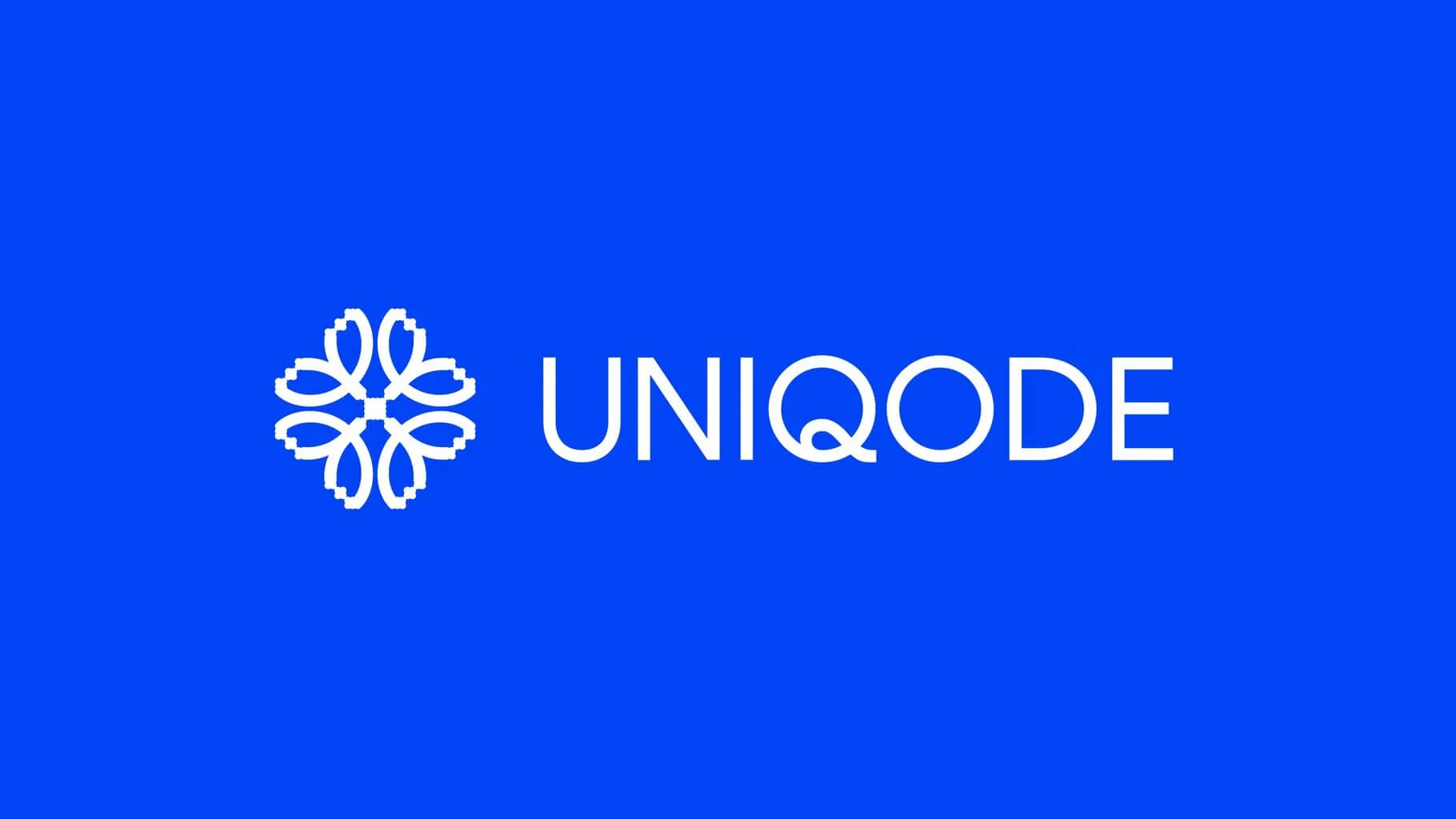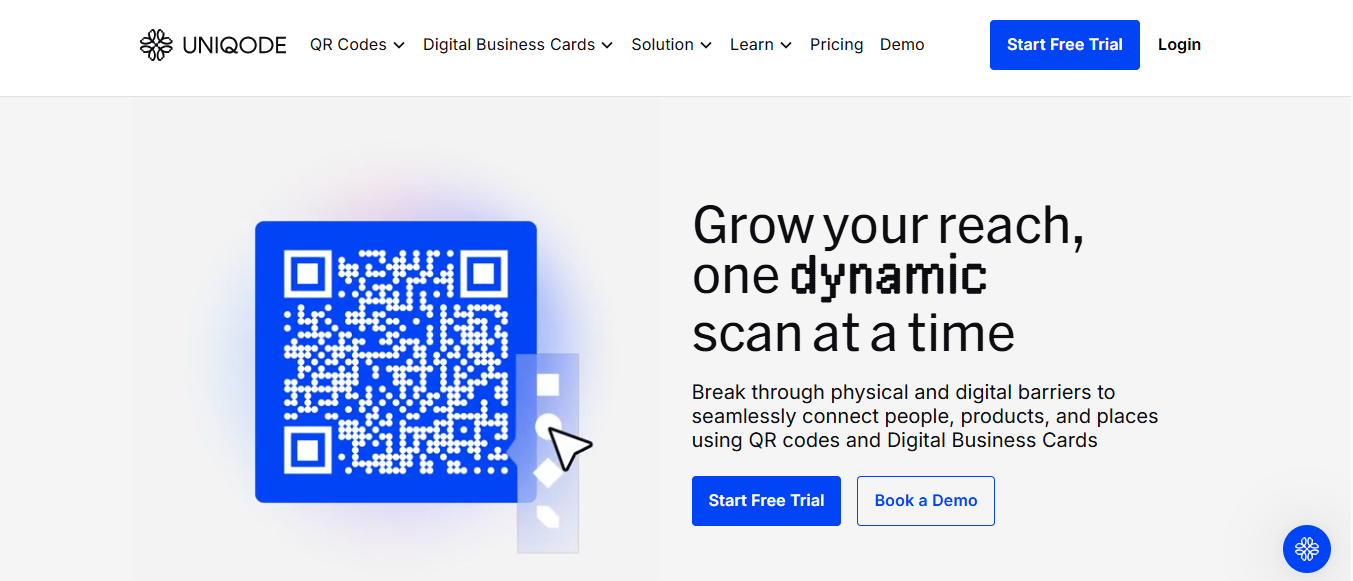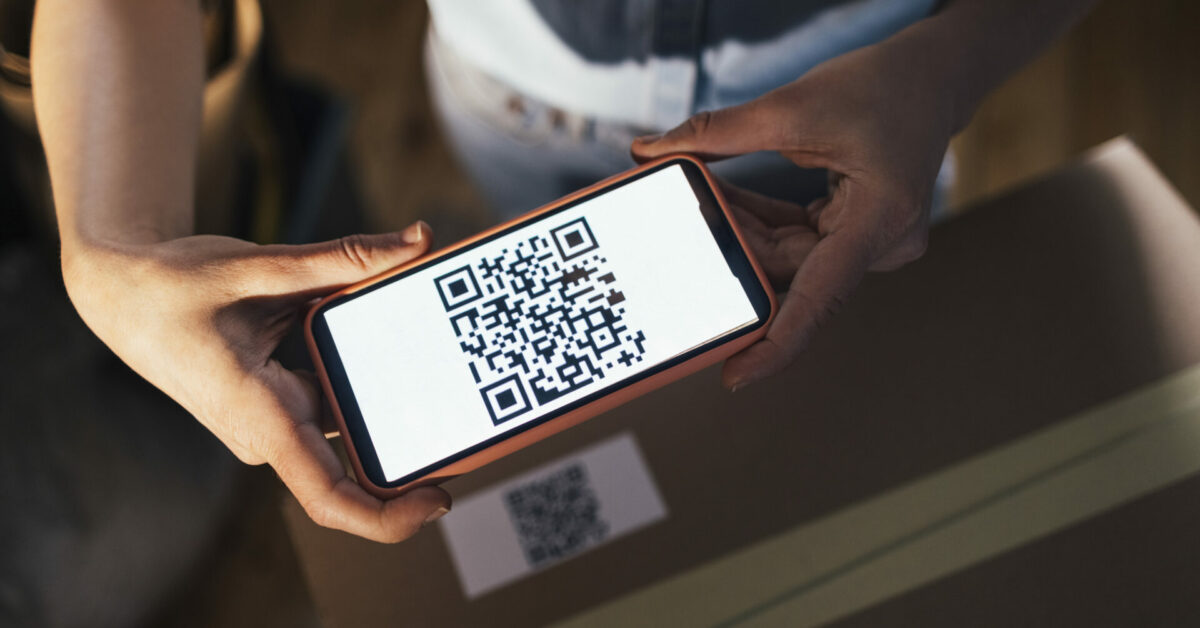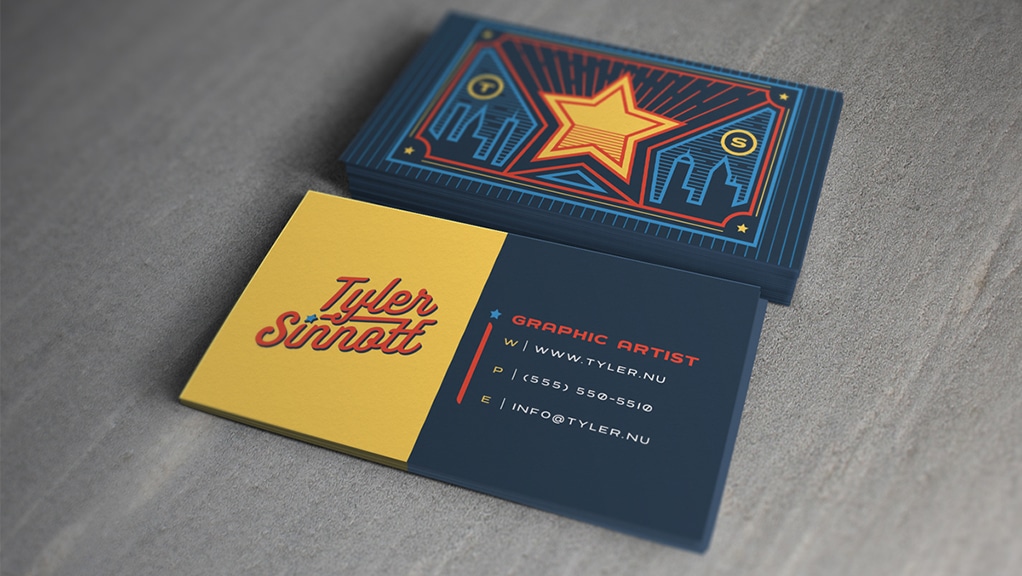.svg)

QR codes are everywhere, from restaurant menus to product packaging, and managing them effectively can make or break a digital marketing campaign. That’s where Uniqode (formerly Beaconstac) comes in. Promising dynamic QR code creation, smart tracking, and enterprise-level security, it’s quickly become one of the most talked-about platforms in the space. In this deep dive into Uniqode reviews, we’ll explore what real users are saying, break down its key features and performance, and look at practical use cases across industries. By the end, you’ll have a clear, no-fluff understanding of whether Uniqode is the right fit for your business goals.
To help with that decision, Mobilo's digital business card gives you a simple way to share contact info, test engagement, and compare real user experience without a complex setup.

Uniqode is a dynamic QR code platform built for businesses that need on-demand digital engagement. It generates branded QR codes and digital business cards, then lets teams manage, update, and measure scans in real time.
The platform positions itself for startups and enterprises by combining customization, analytics, and integrations, allowing a single QR or card to drive web traffic, capture leads, or trigger specific actions on a device.
Uniqode creates both static and dynamic QR codes, manages them from a central dashboard, and tracks every scan. You can embed logos, apply brand colors, and export high-definition images for print or digital use.
Dynamic QR codes let you change the destination URL without reprinting the code. The dashboard reports device type, timestamp, and scan location, which you can use for A/B tests and campaign tweaks.
Uniqode links QR campaigns to marketing workflows and analytics platforms. It supports Google Analytics integration on paid plans, CRM and HRM connections for automated lead pushing, and wallet passes for Apple and Google Wallets. Teams can route scans into retargeting lists, track conversion funnels, and trigger actions based on operating system, country, or time of day.
The QR code generator covers common business use cases like event registration, Wi Fi connectivity, app downloads, coupon pages, social profile growth, and generic website links. You get templates, logo embedding, color controls, and high-resolution export options. For large deployments, you can create bulk QR codes and use enterprise features for consistent branding across thousands of assets.
Uniqode Cards are shareable digital business cards that work across devices and integrate with Apple Wallet and Google Wallet. They let you present a centralized profile containing contact details, social links, portfolio items, and more.
Cards support dynamic updates, allowing you to revise details without resending the link or regenerating the QR code. Two-way contact sharing will enable recipients to submit their details via a form that feeds into your lead pipeline.
Dynamic codes let you update destinations without reprinting labels and support varied content types, from websites to downloads and Wi-Fi credentials. The generator exports print-ready files and supports bulk creation for large-scale rollouts. Note that the free trial limits dynamic codes to three, which constrains exhaustive experimentation.
You can apply logos, color palettes, and templates to keep code on brand. Conditional routing enables different actions based on the operating system, geography, or time of day. Resellers and agencies can use white label options to offer branded QR services to clients.
Cards consolidate your public profile into a single, mobile-friendly page and let you update fields dynamically. Use a single card across email signatures, Zoom backgrounds, and in-person networking to collect leads or prompt contact exchange. Integration points include CRM and HRM systems, enabling a new scan to automatically generate a lead.
The analytics report includes device breakdowns, timestamps, and scan locations, which you can export or integrate into retargeting workflows. Paid plans enable Google Analytics integration and advanced tracking for conversion optimization. Those insights support audience segmentation and ad retargeting based on scan behavior.
Uniqode is used across retail, consumer goods, healthcare, finance, hospitality, and education for product information, contactless menus, patient forms, secure transactions, and student materials.
In the United States, Business Insider projects that QR code scanners will grow from 83.4 million users in 2022 to 99.5 million by 2025, indicating increasing opportunities for QR-based engagement.
Uniqode offers personalized onboarding and responsive support to guide users through design and deployment choices. The platform provides a free trial for the QR generator and a free forever tier for cards.
At the same time, pro and enterprise plans unlock bulk generation, white label controls, GA4 integration, and advanced analytics. Integrations to CRM and HRM require paid plans for full automation.
User reviews often highlight the brandable codes, ease of design, and the usefulness of dynamic updates. Customer feedback highlights strengths in customization and support, while also addressing common critiques about the trial limit of three dynamic codes.
Reviewers compare features, pricing, and support when researching Uniqode reviews, user ratings, testimonials, and case studies. Questions about API access, SDK options, or security features frequently appear in product comparisons and user experience reports.

Restaurants and hotels face demand for faster service and safer interaction. Uniqode QR codes host menus, wine lists, concierge pages, and location-based tour content, allowing guests to scan and instantly access rich media. Use dynamic QR codes to update menus, change seasonal pricing, or swap language versions without reprinting cards.
Link scans to digital business cards for front desk staff, allowing guests to save contact details and request services directly. Many Uniqode reviews highlight how easy the setup is and how managers value the analytics for peak hour planning.
Shoppers want specs, reviews, and quick checkout. Attach Uniqode QR codes to displays and items so customers can access product pages, comparison charts, and customer testimonials from their phones. For payments, use static or dynamic codes that integrate with payment gateways to support contactless checkout.
Launch time-limited promotions through dynamic codes and track which offers convert using Uniqode analytics. Retail owners who read Uniqode reviews often cite the tracking and campaign tagging as a reason they can measure ROI in real terms.
Clinics and pharmacies need secure, quick ways to share schedules and records. Uniqode provides secure QR codes for appointment booking, check-in, and verified access to vaccination records or lab reports.
Send dosage guides and post-procedure care as links tied to each patient visit, and update content without changing the printed code. Providers rate Uniqode features in user feedback for secure access controls and audit-friendly logs that support compliance.
Banks and fintech firms aim to speed transactions while preventing fraud. Use Uniqode QR codes for contactless payments, secure login tokens, and links to live feeds for investment products.
Dynamic codes push real-time data to clients and can route users to KYC or profile update forms that feed directly into your CRM. Developers and compliance teams often note in Uniqode reviews that the platform supports secure redirects and helpful analytics for audit trails.
Print and out-of-home ads need a measurable next step. Place Uniqode QR codes on billboards, posters, and brochures that open product demos, coupon landing pages, or 30-second videos. Use dynamic codes to A/B test creative by swapping the destination without reprinting media.
Track scans, locations, and devices to compare channel performance and collect user feedback. Advertisers consult Uniqode reviews for campaign reporting and conversion tracking when they plan multi-channel spends.
Marketers need measurable touch points that scale. Uniqode lets you create personalized QR codes for influencers, unique codes for each physical flyer, and dynamic destinations to test offers. Monitor scan rates, time of day, and geography to optimize budget allocation.
Use digital business cards to capture leads at events and feed them into nurture sequences. Case studies and Uniqode reviews often point to the platform's A/B testing and reporting as reasons campaigns become more efficient.
Events struggle with bottlenecks and crowd direction. Issue tickets with unique Uniqode QR codes for contactless entry and tie scans to attendance tracking. Post-session QR codes collect real-time feedback and allow speakers to share materials instantly.
Use location-based codes around a venue to deliver maps, schedules, and exhibitor pages. Event managers consult Uniqode reviews for reliability and the ease of exporting attendee data for follow-up.
Uniqode supports dynamic QR management, analytics, secure access controls, and API integration, allowing teams to update destinations, track performance, and feed data into CRMs without reprinting assets.
Digital business cards sync contact details to phones and CRM systems, making follow-up faster. Reviews and customer feedback often highlight the platform s ease of use, responsive customer support, and transparent pricing as reasons organizations choose to implement it at scale.

Set a clear type hierarchy by size. Use the largest point size for the company or personal name so it reads first. Put job title and taglines in a medium size. Place contact details smaller, but never below about 7.5 to 8 points for print on standard cardstock; many printers recommend 8 to 9 points as a practical minimum for legibility.
Always print a one-to-one mockup and read it from a normal holding distance to ensure these are clear:
Limit fonts to one or two families. Pick a primary font for name and headlines and a secondary font for contact details or body text. Use family variations like weight and italic rather than adding new typefaces.
This keeps your card cohesive and supports strong brand typography and type hierarchy without cluttering the layout.
Choose a font that reflects your business identity.
Ask yourself which emotion you want the card to convey and test a few options at the final size to see which aligns with your corporate identity.
Give content room to breathe. Maintain consistent margins and a generous safe zone so text never sits too close to the edge or the logo. Use line spacing that makes multi-line elements easy to scan; for contact blocks, set leading slightly above single spacing to improve readability.
White space guides the eye and increases perceived quality of the card.
Add thin rules to separate zones or to anchor the logo and contact block.
Keep lines simple:
Use alignment so lines tie visually to type elements. Avoid ornate or heavy decorations that compete with type; lines should clarify hierarchy and direct attention.
Match the tone and weight of type to the logo. If your logo is bold and heavy, use lighter weights to avoid fighting for dominance. If the mark is delicate, choose a sturdy companion typeface so the text reads at small sizes.
Place the logo and text on a verbal and visual grid so neither overshadows the other. Test the whole composition in grayscale to confirm balance without color cues.
To avoid awkward gaps, manually adjust kerning for:
Use tracking to tighten or loosen longer lines of text, but avoid extreme values that impair legibility. Set the line height so that stacked information, like address lines, reads without collision. Minor adjustments can improve readability and create a polished, professional finish.
To lead the viewer, use:
Balance clarity with hierarchy so every element earns its visual weight:
Ask which information must stand out and apply a stronger contrast there.
Choose fonts with good print rendering and avoid extreme display faces for small text. Convert type to outlines or embed fonts when sending print files to prevent substitution. Check the color mode for print in CMYK, and plan special finishes like foil or embossing, which can reduce legibility for wonderful strokes.
Allow for printer safe zones and bleed, and run a press proof when possible to confirm crisp type at the final size.
Consider these options by brand need and legibility:
Use scripts or decorative display fonts only for single, significant elements like a signature or accent word, and never for contact lines. Test each face at actual print size to confirm stroke thickness and counters hold up.
Pair a neutral sans with a modest serif for readable contrast. Use matching x heights or optical balance to keep pairs consistent. When pairing, let one family dominate and use the other sparingly.
Try one font for the name and one for contact details, or use a single family with two weights to simplify alignment and kerning.
Prioritize legibility for people with low vision by choosing open letterforms, avoiding condensed faces, and ensuring sufficient color contrast. Keep phone numbers and email addresses in plain, machine-readable layouts for mobile scanning.
Use simple separators like dots or vertical bars to break up lines so scanning apps and eyes find data quickly.
Which element will you test first on a printed proof?

Mobilo helps teams transform networking into a measurable pipeline.
Tap to:
The platform automatically:
Over 59,000 companies use Mobilo to increase lead capture and follow up at conferences and meetings.
Mobilo uses NFC and QR triggers, allowing a single interaction to create a full lead record.
The system enriches raw contact data with:
Built-in lead scoring compares behavior and attributes to your ICP, allowing sales to see prioritized prospects first. It maps fields to your CRM in real time so reps never rekey details.
Paper cards sit on tables or get stuffed into wallets and then forgotten. Sales teams waste hours typing contacts and correcting errors. With Mobilo, you capture information at the moment of contact and maintain audit trails, timestamps, and event context for every exchange, ensuring follow-up occurs while the meeting is still fresh.
Teams report up to 10x more leads at events because every exchange becomes a trackable, actionable record. Lead quality improves through enrichment and scoring, and pipeline velocity increases when qualified contacts land directly in your CRM.
Book a demo today and get your first 25 cards free (worth $950). If 90% of business contacts never make it into your CRM, you cannot afford to keep using paper cards.
Choose fonts that stay legible at small sizes and match your brand voice.
These fonts read well in compact layouts: clean sans-serif fonts like:
Classic serif choices such as Garamond, Baskerville, Georgia, and Times New Roman work for formal brands.
Avoid tight script or ornate display fonts for contact lines. Consider using professional, modern, classic, and clean fonts when designing both print and digital cards.
Set a clear hierarchy: name first at 14 to 20 point depending on typeface, role, and company at 8 to 12 point, and contact details at 7.5 to 10 point to keep everything readable. Use letter spacing and kerning to improve clarity for smaller text. Maintain consistent leading so lines do not crowd. Test the readability of digital cards at the actual card size and on mobile screens.
Want to see how this lowers friction and improves follow-up? Book a demonstration today and get your first 25 cards free (worth $950).
Join over 59,000 companies already using intelligent digital business cards that automatically exchange contact information, enrich lead data, score prospects against your ICP, and sync directly to your CRM.
• Vistaprint Digital Business Card
• Blinq vs Linq
• HiHello Alternatives
• Popl Alternatives
• How to Create a Digital Business Card on Android
• Google Digital Business Card

Uniqode connects physical items and print with web experiences through dynamic QR codes and digital business cards. Companies use it to update content without reprinting, capture leads at events, tag on product packaging, and drive paid media retargeting. More than 50,000 businesses run campaigns, manage assets, or equip teams with branded QR experiences on this platform.
The platform focuses on dynamic QR codes that you can edit after distribution. Users emphasize the ability to change destinations without replacing printed material, while teams use branded QR visuals and templates to ensure codes align with their identity. This capability reduces reprint costs and lets marketers react when campaigns shift.
Uniqode collects scan metadata so teams see who scans, when, and where. Reviewers praise the analytics for conversion signals and for feeding downstream tools. Integrations with tracking pixels and analytics platforms allow marketing teams to link scans to retargeting and attribution workflows, rather than treating scans as anonymous hits.
You can deliver different content based on time, location, device, or user behavior. Marketers report that smart rules let them route traffic to store pages, special offers, or localized messaging automatically. This feature turns one physical touchpoint into multiple targeted experiences.
Uniqode connects to more than a thousand tools, including Google Analytics, Meta Pixel, and Zapier, plus a public API for bulk or automated workflows. Users who automate workflows highlight faster lead handoff and simpler audience building for retargeting. API and integration reliability vary by use case and complexity.
Enterprises deploy large sets of code across locations and teams. The product offers role-based access, bulk creation tools, and account management for multiple organizations. Customers report confidence in uptime and in enterprise-grade security controls, and IT teams commonly cite 99.99% uptime as a selling point.
Many reviewers call the interface intuitive and fast to learn, noting minimal friction when creating custom codes. Small teams appreciate quick setup and straightforward design flows. Some users find advanced customization and error page configuration less noticeable, which can require help from support or documentation.
Users regularly praise the depth of analytics, scan volume, geolocation trends, device mix, and conversion paths. These analytics help marketing teams optimize placement and creative. A subset of reviewers reports issues with retrieving specific datasets or with historical entries remaining after code deletion.
Support receives mixed but mostly positive feedback. Several users praise fast, helpful responses and hands-on assistance during onboarding. A small set of reviews mentions billing disputes or slower resolutions for complex integration problems, which can disrupt critical campaigns.
Bulk creation and large-scale uploads draw mixed reactions. Some users find multi-step bulk workflows and third-party connectors cumbersome. A few report occasional service interruptions or odd login behavior that affects integrations and team access when timing matters.
Price sensitivity appears in reviews. Some users feel the platform is premium-priced relative to simple QR generators and want clearer tier boundaries or more economical options for higher code volumes. Others accept the cost for enterprise features and analytics that basic tools lack.
Recurring issues include clunky data retrieval in certain instances, lingering entries after code removal, and occasional integration failures. These points come up less often than praise for usability, but they matter for teams that rely on tight workflows and billing transparency.
Marketers running omnichannel campaigns, retail teams with in-store signage, event organizers capturing leads, and enterprises managing asset tags gain the most. If you need dynamic destinations, pixel-level retargeting, and central control over thousands of codes, Uniqode matches those needs.
Getting answers to these helps match Uniqode to budget and operational needs.

Mobilo replaces paper cards with smart digital business cards that exchange contact information automatically at scale. Teams capture contact details at the moment of interaction, then enrich those records with firmographic and behavioral signals so leads arrive ready for action.
Mobilo uses NFC and QR code taps to transfer data instantly, with no app required for recipients. The card hardware remains professional on the table, while the software enhances every handshake with context. This avoids manual entry errors and preserves the human moment while converting it into clean digital data your marketing and sales stacks can use.
Mobilo syncs bidirectionally with major CRMs, so records, activities, and notes flow into the systems your teams already use. No export files, no manual import, no lost contacts. Workflows can assign territories, create tasks, and kick off nurture sequences immediately after an event interaction.
People researching digital card vendors often look for product reviews, pricing comparisons, and user experience reports. Terms such as Uniqode Reviews, Uniqode pricing, Uniqode features, Uniqode testimonials, Uniqode comparison, and Uniqode user experience appear in many buyer searches when comparing platforms that offer NFC or QR code business cards.
Check customer reviews, case studies, and integration lists to see which solution matches your priorities for security, ease of use, and CRM support.
When contact data flows automatically, you need controls for consent, storage, and access. Mobilo provides permissions and enterprise features to manage data retention and compliance with privacy rules. Also, check vendor documentation and customer feedback on data handling and security practices before you deploy across the company.